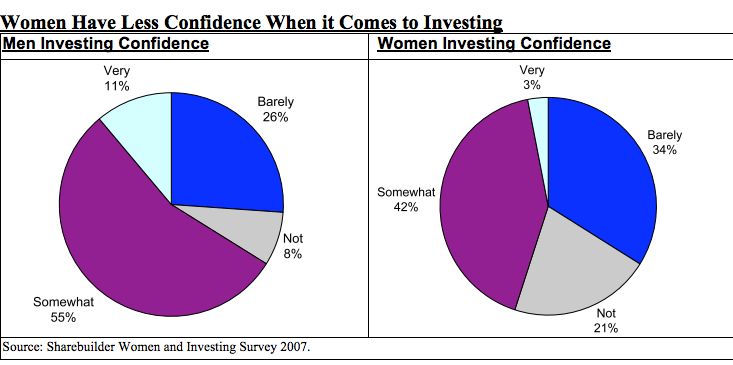 During my recent interview with the financial services pioneer Bridget Macaskill, one of the most compelling subjects we discussed was the difference between women and men investors. Back in 1992, Macaskill conducted a groundbreaking study on the habits of women investors and was surprised to find that the majority of women felt intimidated by the investment process, leaving many ill-prepared for retirement.
During my recent interview with the financial services pioneer Bridget Macaskill, one of the most compelling subjects we discussed was the difference between women and men investors. Back in 1992, Macaskill conducted a groundbreaking study on the habits of women investors and was surprised to find that the majority of women felt intimidated by the investment process, leaving many ill-prepared for retirement.
More Confident, But Less Prepared
It has been twenty years since Macaskill conducted that revelatory study, and since then some things have changed, and others have remained the same. One major improvement has been in women’s confidence in investing. A 2011 study by TD Ameritrade found that 94% of women investors surveyed reported that “they are quite confident or level-headed and don’t let their nerves get the best of them when managing their portfolios.”
However, TD polled women who are primarily online, self-directed investors, which means that those respondents are much more investment savvy than the majority of women investors.
This week, Ameriprise Financial released a study which found that, though women are as confident as men about their investments, they are lagging behind when it comes to financial preparation. Sometimes confidence doesn’t always translate to readiness. The study found that:
- Only 44% of female respondents say they’ve contributed to a workplace retirement plan, compared to 51% of males.
- Ten percent fewer women than men have set aside funds in their own investments (42% vs. 52%).
- One in five (19%) have determined the amount of income they’ll need in retirement compared to 28% of males.
Doing More With Less
Being financially savvy is important for everybody, but it is even more crucial for women. Statistically, women live longer, and earn less than men, which means that they have to stretch a smaller amount of money further. The Ameriprise press release announcing the study findings states:
“This lack of financial planning is especially concerning because many women face unique challenges in preparing for retirement like lower earning power and more time spent out of the workforce to be a caregiver.”
A major reason behind women’s failure to adequately plan for their retirement is that, in the past, investments were often considered a man’s domain. Suzanna de Baca, vice president of wealth strategies at Ameriprise, explains to CNBC’s Paul O’Donnell:
“Fifty years ago, women were financially dependent on other people. For most women, financial responsibility is a new concern, and people have not been talking to women about retirement.”
Engaging Women Investors
While Macaskill was an industry pioneer in the early 90s for conducting a study on women and investing, today things are very different. Almost every firm in the financial services industry has devoted special attention to how women invest money for one major reason: women represent a great opportunity for growth within the financial services industry.
Women are more financially powerful than ever before. They make up half of the U.S. workforce and are the primary breadwinners for 40% of US families. In order to stay competitive, investment firms must cater to the woman investor. Fidelity Investments recently held a forum on how to engage female clients. Financial Planning reports:
“Compiling its own proprietary research, third party research, expert input and responses from interviews with nearly 20 advisors, Fidelity developed a guidebook for advisors on engaging female clients that Laura Kogen, Fidelity’s vice president of practice management and consulting, presented at the forum.”
Fidelity’s main research findings are:
- Gender impacts approach to financial planning, with women focused on holistic planning, while men are focused on investment return.
- Women typically are more risk averse than their male counterparts.
- Women may be better candidates for financial advice due to their willingness to receive advice.
As more companies follow Fidelity’s lead by equipping their financial advisors with the training, research, and tools to better serve their female clients, the benefits of this type of tailored approach will be tremendous for both investment firms and women investors.





